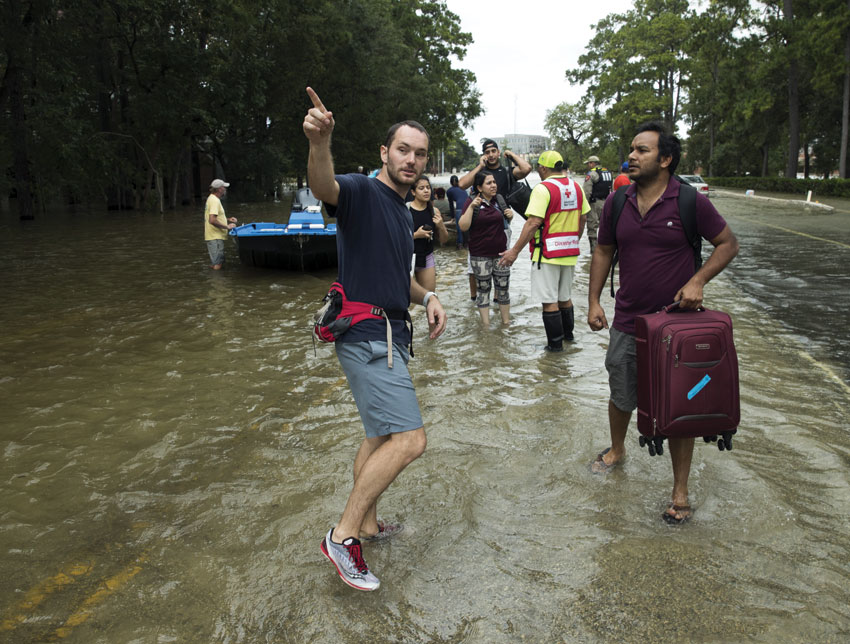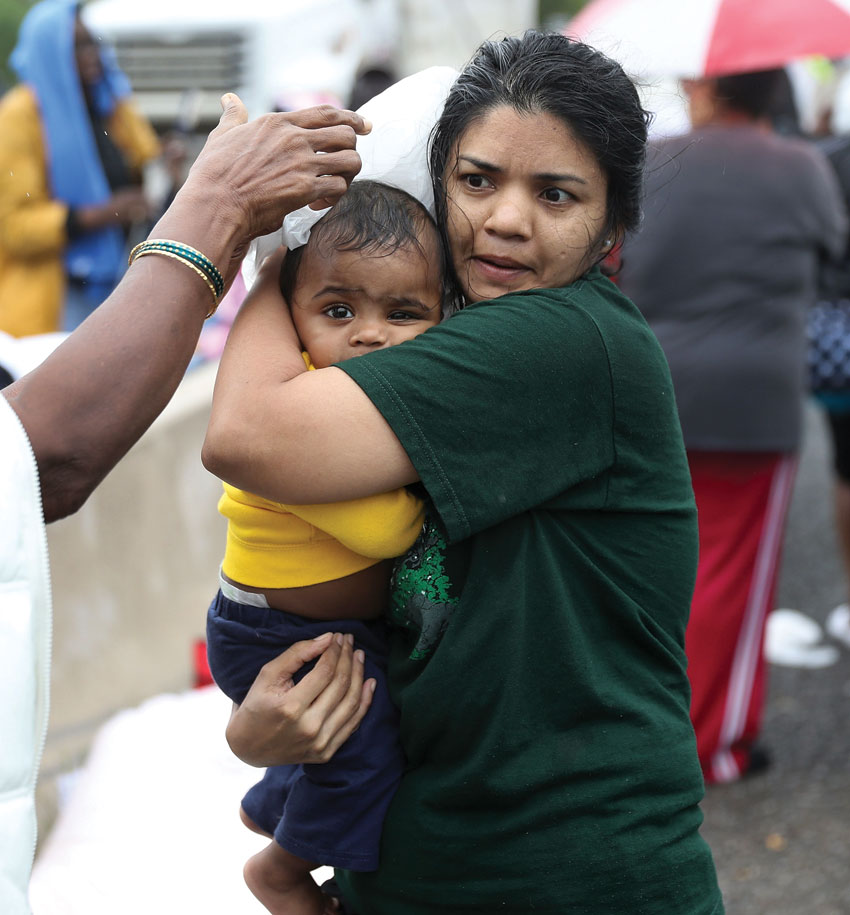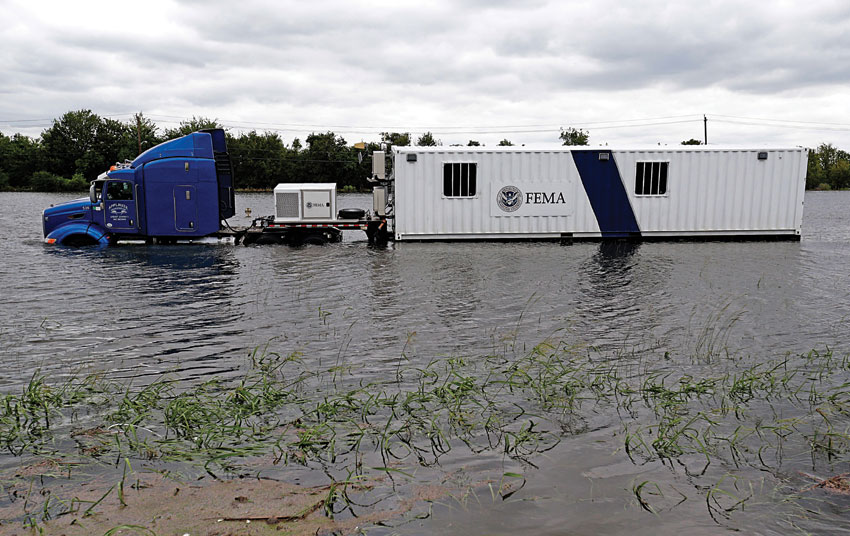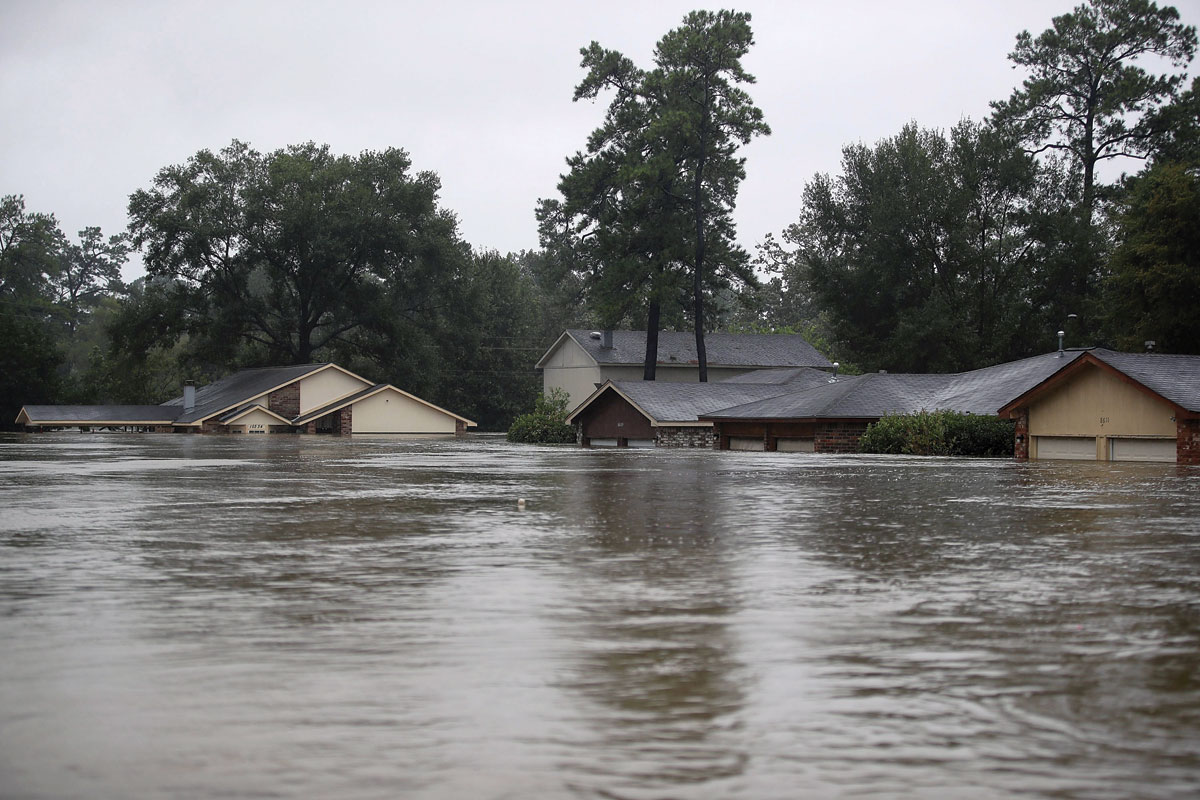Harvey Wreaks Havoc: Costliest Natural Disaster in U.S. History
Homes are seen inundated with flooding from Hurricane Harvey, Aug. 28, in Houston, Texas. Harvey, made landfall north of Corpus Christi late evening on Aug. 25. (Joe Raedle/Getty Images)
Hurricane Harvey, the costliest natural disaster in U.S. history, may cost a whopping $160 billion in economic damages in Texas which resulted in massive destruction, killing 38 people and leaving tens of thousands homeless. Many Indian Americans, living in safer Texas neighborhoods, are helping many Houstonians still stuck by Hurricane Harvey by opening their homes and distributing fresh food, medical and essential needs, writes Seema Hakhu Kachru. Storm-battered Texans faced a worrying new threat as potentially harmful smoke spewed from a swamped chemical plant near Houston, as Harvey’s floodwaters began to recede.
Harvey, now a tropical depression, made the second landfall Aug. 30, slamming into the Louisiana coast near the Texas border hitting the region with record-breaking rainfall and devastating floods.
Harvey has brought the heaviest rainfall in U.S. history, soaking Texas with more than 52 inches since it first made landfall, Aug. 25.
At least 38 people have been killed as a result of the devastating floods and that number was climbing as water receded, revealing the storm’s awful toll, officials were quoted as saying by the New York Times.
At press time, twenty people still remained missing in the city, according to Houston Police Chief Art Acevedo.
The flooding in Houston, the fourth largest U.S. city, is slowly receding in some areas for the first time since the weekend, authorities said, Aug. 31.
Taking advantage of a less rainfall in Houston, Harris County authorities finally located a van, containing six members of the same family, that had been washed off the road days earlier.

All six were dead in what police say is the single deadliest incident stemming from Harvey, with victims ranging in ages from six to 84.
More than 32,000 people were in shelters in Texas, and 30,000 shelter beds were available, Texas Governor Greg Abbott said.
Accuweather estimated Harvey’s cost at $160 billion, making it the costliest natural disaster in U.S. history.
AccuWeather president Joel Myers called Harvey a “1000 year Storm” and said parts of Houston will be uninhabitable for weeks, or even months.
More than 30,000 people took refuge 200 shelters, about 1,800 evacuees have been moved to hotels and other long-term housing options, said Brock Long, Administrator of the Federal Emergency Management Agency.
In Houston, authorities opened two more mega shelters after the convention center quickly became packed with almost 9,000 evacuees.
The National Hurricane Center warns of continuing flooding in parts of southeast Texas and southwest Louisiana.
Nearly all of the reported Harvey-related deaths resulted from people drowning in their flooded vehicles.
One Indian student died, Aug. 30, after he nearly drowned in a swollen lake in Texas. More than 100,000 Indian Americans living in and around Houston have also been badly hit by the monstrous hurricane.
The Indian American community has rallied themselves around to help people in distress. Indian businesses and places of worship were providing shelters to the displaced.
Sunil Thakkar, a radio jockey by profession, was using his station to provide directions to people to safer places.
“This unprecedented disaster had many volunteers working well into the wee hours of early morning, monitoring requests, assessing the situation and coordinating assistance,” said Achalesh Amar, a community leader.
Indian Americans help in Rescue Operations during Harvey. While government agencies were working round-the-clock in relief efforts, the Indian community also rallied together to pitch in with whatever help they could in terms of food, shelter and rescue operations.
“I have organized 1,500 meals from the Dawoodi Bohra Masjid to be delivered to the needy and dispatched 100 volunteers,” Abeezar Tyebji, a resident said.
Indo American Chamber of Greater Houston and local restaurant Madras Pavilion have been sending over 500 meals to the convention center where the evacuees are housed.
Heartwarming stories poured in from all quarters highlighting the efforts made by the community and over 100 volunteers working to help those in distress.

Fears Over Texas Chemical Plant, as Houston Floods Ease. Storm-battered Texans faced a worrying new threat, Aug. 31, as potentially harmful smoke spewed from a swamped chemical plant near Houston, as Harvey’s floodwaters began to recede in America’s fourth-largest city.
Vice President Mike Pence flew into Texas accompanied by top cabinet officials to assess damage from the devastating storm and meet with victims, with the situation still dire in towns east of Houston such as Beaumont and Port Arthur. President Donald Trump and First Lady Melania Trump also visited the flood-ravaged state.
As flooding began to ease in Houston itself, bringing some relief to its 2.3 million residents, a series of overnight explosions sent a plume of toxic smoke spewing from a flooded chemical plant in Crosby, a town of around 3,000 people some 25 miles northeast of the city.
Officials ordered residents living within 1.5 miles of the facility to evacuate.
Brock Long, the head of the U.S. Federal Emergency Management Agency, said the plume of fumes was “incredibly dangerous.”
But the U.S. Environmental Protection Agency said it was reviewing data from an aircraft that surveyed the scene and had no indication that dangerous amounts of toxic materials have been released.
“This information indicates that there are no concentrations of concern for toxic materials reported at this time,” it said.
Fifteen sheriff’s deputies who responded to the fire were briefly hospitalized and later released.

Company officials sought to tamp down the threat, while saying they do expect more fires at the facility owned by the French company Arkema.
“We believe along with the local authorities that we’ve moved everyone out of harm’s way, and that no one is in danger based on the fire that we expect,” Richard Rennard, a senior Arkema executive, told a news conference.
The overnight fire was triggered after a container of organic peroxides could no longer be refrigerated due to flooding that cut off electricity and flooded emergency generators.
The chemical plant makes compounds with many commercial uses, including plastics, pharmaceuticals and construction materials—compounds that can combust if not cooled to the proper temperatures.
Rennard said eight other containers of organic peroxides were in danger of catching fire.
“We fully expect that the other eight containers will do the same thing,” he said.
Rennard encouraged anyone who has been exposed to the smoke to seek medical advice, while stressing: “It’s not a chemical release that’s happening… What we have is a fire.”
The company said organic peroxides could cause eye, skin or respiratory irritation as well as nausea, drowsiness or dizziness, and urged nearby residents to turn off their air conditioners to avoid possible smoke exposure.
“The smoke is noxious. Toxicity is a relative thing,” Rennard said, declining to elaborate.


